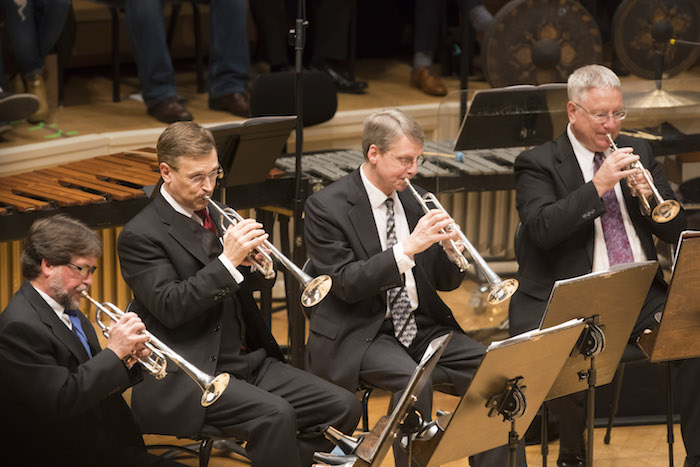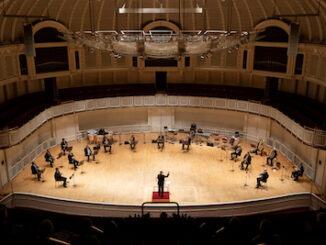
On December 20th, 2017 the legendary brass section of the Chicago Symphony Orchestra, lauded for its “incredible power, matchless brilliance and dazzling virtuosity” performed a fine concert of symphonic masterworks and traditional favorites.
The Brass performers, conducted by Michael Mulchay, trombone, included horns Daniel Gingrich, Acting Principal, James Smelser, David Griffin, Oto Carrillo, and Susanna Gaunt; the trumpets included Mark Ridenour and John Hagstrom. The remaining Brass included Jay Friedman, Principal trombone, Charles Vernon, bass trombone, Gene Pokorny, Principal tuba, percussionists Cynthia Yeh and James Ross and David Herbert, timpani.
Guest musicians of the Chicago Lyric Opera Orchestra included William Denton and Channing Philbrick, trumpets; Anna Spina, horn; Jeremy Moeller, trombone; and Mark Fisher, trombone and tenor tuba.
Members of the Brass took turns introducing the concert and the pieces with great wit and obvious camaraderie. Present in the audience were some 1000 music educators and their students, in Chicago for the Midwest Clinic for band and orchestra. The audience was advised, “Committed music teachers are the future of music in this country, and we need them now more than ever”.

The program consisted of:
– Jan Van der Roost Canzona. Homage to Giovanni Gabrieli from Tre Skizze, 2007
One of the most important composers of European wind music today, Van der Roost is part of a generation of artists who have, in recent decades, extended the repertoire with intriguing and original works. The title of this piece, for brass ensemble and percussion, means “3 sketches”; a canzona is an instrumental arrangement of a French or Flemish song, typical of 16th-century Italy.
Michael Mulcahy noted in CSO Sounds and Stories, “This piece was written very much in the arc of a Gabrieli canzona… It starts out like that but then goes into some outlying areas in time and space that take you forward to our time and on to fantasy. It takes the idea of a canzona and turns into something like a hallucination.”
The canzona was a fanfare of diverse motifs, with a melancholy mid-section after which a charming percussion fusillade heralded a climax of triumphant chords.
– Michael Tilson Thomas Street Song for Symphonic Brass, 1988
Street Song, it has been written, is “steeped in musical influences of Tilson Thomas’ youth.” The composer’s program notes remark that the harmonies of the first movement alone, “move between the world of the Middle Ages and the present, between East and West, always … from the perspective of twentieth-century America”, and the piece has been described as “overwhelmingly set in an Americanist idiom”.
This melodious piece began with a strongly sentimental feeling that transformed into a street scene, ending in a serenade.

– Gavin Higgins Sinfonietta for Brass Ensemble and Percussion, 2006
Described as “boldly imaginative” and “extraordinary”, Higgins has been consistently praised by critics for his distinct and visceral style. The Gloucester-born composer is descended from a lineage of brass band musicians dating back to 1895; he followed an initial musical training in the family brass band, and studied French horn and composition. Higgins has continued this heritage with high profile commissions and performances of vital and daring brass band pieces.
His 4-movement Sinfonietta began with an Allegro climaxing with gay cymbals, continued through the lively “Arias” infused with Latin sonority, moved fluidly through a clever and picturesque Scherzo and concluded with a finale reminiscent of big-top music.
–Einojuhani Rautavaara A Requiem in Our Time, 1953
This composition, neoclassical in style, brought Rautavaara international attention, winning him the Thor Johnson Brass Composition competition of 1954.
It’s a dramatic work; the first movement, which contains numerous changes in metre, opens with a trombone/trombone fanfare. The second movement starts with a muted trumpet/horn in staccato bursts followed by occasional horn and low brass segments in a deeply sonorous chorale. The third movement, sharply articulated, gives way to a slow, gentle finale. A reviewer of the Australian premiere on April 8, 2011 in Sydney noted that the work combines “conciseness and economy of utterance with an opulent and romantic sense of expression”. The Brass played this piece with a sense of excitement; the 4 movements were deeply stirring.

– Giacomo Puccini, arr. Geoffrey Boyd, Highlights from Turandot, 1926
The selections from Turandot, dedicated to the composer’s granddaughter Simonetta Puccini, a strong supporter of her grandfather’s memory, were thrilling. The audience was advised that this opera, even though it contains “the 2 most despicable heroines”, also contains arguably the most famous tenor aria in all of opera, “Nessun Dorma”. The presentation this night was a combination of awesome scale and exquisite detail, with strong harmonies and intense brass effects. It was filled with themes that ran the gamut of lyrical passion from fragility to “lurid darkness”; this is some of the great master’s most vivid and complex work.
– In encore, The Chicago Symphony Orchestra Brass performed In the Bleak Midwinter, a Christmas carol based on a poem by the English poet Christina Rossetti which was published under the title “A Christmas Carol”, in the January 1872 issue of Scribner’s Monthly. The poem first appeared set to music in The English Hymnal in 1906 with a setting by Gustav Holst. Harold Darke’s anthem setting of 1911 is more complex, with different melodies for each verse and was named the best Christmas carol in a poll of some of the world’s leading choirmasters and choral experts in 2008.
This night’s arrangement was by John Higgins, and was hauntingly beautiful. Exquisitely melancholy and evocative, the text of the underlying poem describes the Nativity in a snowy Northern landscape. The Brass concluded the refined repertoire of the concert with this tenderly sentimental traditional carol.
For information and tickets to all the fine programs of the Chicago Symphony Orchestra, go to www.cso.org
All photos by Todd Rosenberg


Be the first to comment